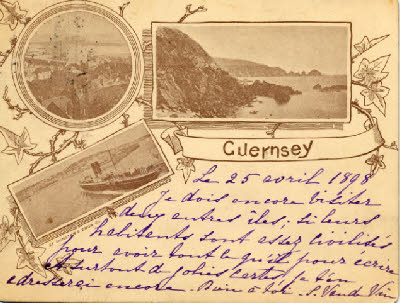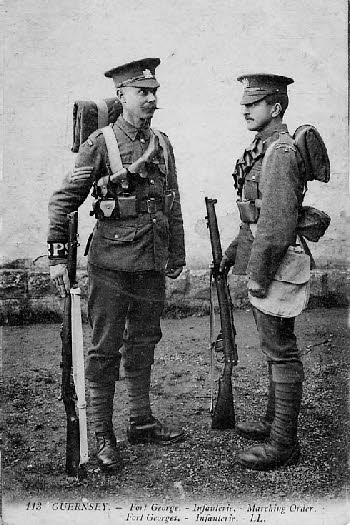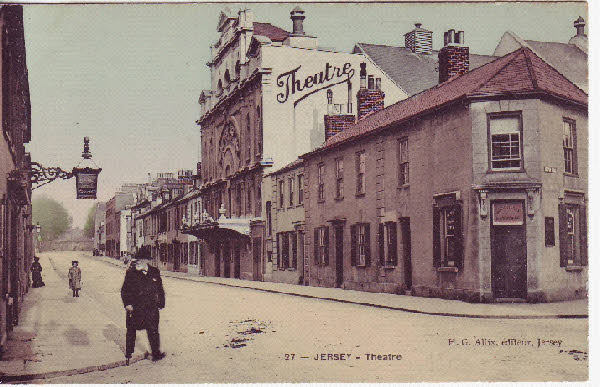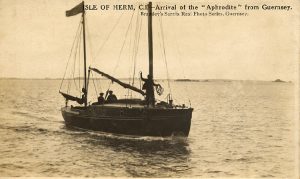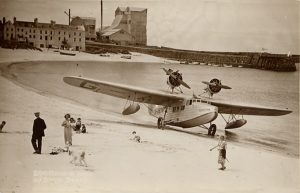POSTCARDS OF THE CHANNEL ISLANDS
The Post Office first allowed picture postcards to be sent through the post with an adhesive stamp at the postcard rate in September 1894. For several years only “court” size, 3.5 inches by 2.5 inches were allowed. At this time the cards had a picture side with room for a message, and the other side had the word “postcard” on it, and could only be used for the stamp and the address. In November 1899 the limit on the size of card was raised to 5.5 inches by 3.5 inches. These early cards are known as vignettes as the picture does not occupy all the space. In 1902 the address side was divided into two and the left side could be used for a message. Following this, the picture could now occupy the whole space.
Details of when cards were first published are meagre, and often non-existent, so the dating of cards of different publishers and series is usually done using the date stamps on cards that have been through the post. The earliest recorded card of the islands, according to the Picture Postcard Annual, is Jersey 15th July 1895.
Postcards proved very popular and the twentieth century heralded in the golden age of postcards, a period of nearly two decades extending from 1900-1918. Thousands of cards with Channel Island views were produced by a large number of national publishing firms – some of the most prolific were Judges of Hastings, The Photochrom Co. of Tunbridge Wells, Raphael Tuck of London, Valentines & Sons of Dundee and J Welch & Sons of Portsmouth. The international company of Lévy Sons & Co. produced European and North African view cards. The titles on these printed cards are followed by the letters LL, and these postcards of the Channel Islands have become very collectable.
Many local photographers and shopkeepers also produced postcards. As they were present throughout the year, they were able to record not only views but important events, and these cards have become invaluable for Social History research.
In the very early days, prominent among these locals in the Bailiwick of Guernsey were Guernseyman F.W. Guerin, and T.D. Westness in Alderney. In Jersey it was Albert Smith, George Barre and H.G Allix.
T. A Bramley moved to Guernsey in 1910 and lived there for the rest of his life. His postcards are dated from 1907 until about 1930.
Having moved from Somerset to Alderney, father and daughter W & E Bailey produced several hundred cards of the Bailiwick of Guernsey in the 1930s. A.G. Le Moer produced cards of Jersey, and returned after the Occupation to take images from roughly the same spot.
Thomas Grut and his son Norman covered all the islands in the Bailiwick of Guernsey, producing postcards from the beginning of the 20th Century until the early 1970s.
Picture postcards of the islands continue to be published and over the years the size restrictions have been relaxed. The modern cards are larger, and are more colourful.
Research in this area is limited at present, however the following publications are useful:
| Mallet, Bob. | A Catalogue of Jersey Postcards published by Levy Sons & Co. Published by ELSP Seaflower Books 2014. |
| Larbalestier, C. E. | The Postcards of Henry George Allix. Published by Société Jersiaise, Jersey. 2004. |
| Bailey, Mark. | A Collection of Black & White LL Postcards of Jersey CD-ROM. Published by Channel Islands Specialists’ Society. |
| Byatt, Anthony. | Picture Postcards and their Publishers. Published by Golden Age Postcard Books. 1978. |
| Staff, Frank. | The Picture Postcard & its Origins. Published by Lutterworth Press. 1966. |

